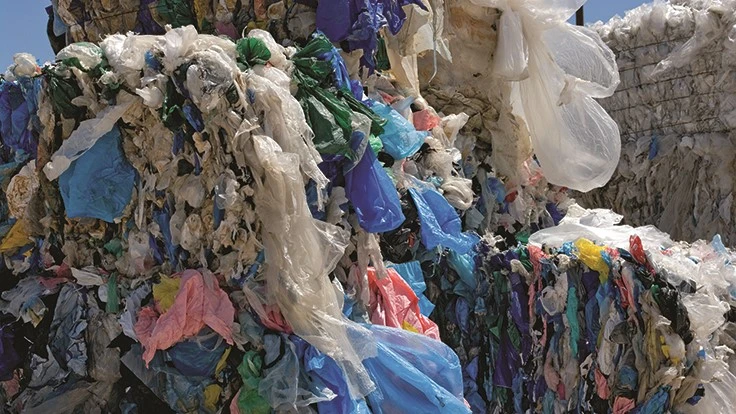
Huguette Roe | dreamstime.com
The COVID-19 pandemic combined with low virgin resin pricing and a vastly reduced overseas export market affected plastic recycling in North America in 2020, according to a report sponsored by the Association of Plastic Recyclers (APR), the Foundation for Plastic Recycling, The Recycling Partnership and the U.S. Plastics Pact.
The “2020 U.S. Post-consumer Plastic Recycling Data Report” was compiled by Stina Inc., Sonoma, California, based on surveys conducted by the company and the National Association for PET Container Resources (NAPCOR), Charlotte, North Carolina. The report looks at the primary postconsumer plastic categories recovered for recycling, including bottles, nonbottle rigids, film and other plastics.
According to the report, most major categories of plastic recovered for recycling saw a decrease in total pounds reported in 2020 compared with 2019. Nonbottle rigids saw the largest decrease, down 206.1 million pounds. Bottles decreased by 91 million pounds. However, film collection increased by approximately 8 million pounds compared with 2019.
Major disruptions in collection, transportation and staffing shortages, as well as supply chain issues, affected the supply of material available for recycling, according to the report. Despite those challenges, the trend of more U.S.-sourced postconsumer plastics remaining within North America continues. Of the postconsumer plastics sourced in the U.S., only 8 percent were exported overseas.
In 2020, a total of 4,803.8 million pounds of postconsumer plastics sourced in the U.S. were recovered for recycling, a decrease of 5.7 percent compared with 2019. Bottles, nonbottle rigids and other plastics (excluding foam) saw declines in the amount of material recovered for recycling in 2020, with film collection up by just less than 1 percent. In aggregate, recycling of bottles, nonbottle rigid plastics, film and other plastics declined by 290 million pounds in 2020 compared with 2019, according to the report.
North American reclaimers acquired 97 percent of the 2,744 million pounds of bottles recovered for recycling in the U.S. in 2020, a 24.6-million-pound decrease from 2019. Polyethylene terephthalate (PET) and high-density polyethylene (HDPE) bottles made up 98.8 percent of this total recovery at 64.4 percent and 34.4 percent, respectively, the report notes. The combined bottle recycling rate was 27.2 percent, down from 28.7 percent in 2019, with the PET bottle recycling rate at 27.1 percent and HDPE at 28.8 percent. Bottles continued to make up most of the plastic recovered for recycling at 57.1 percent, while nonbottle rigids accounted for 22 percent; film, 20.5 percent; and other plastics, 0.3 percent.
The nonbottle rigids category declined by 206.1 million pounds in 2020. Most of that material recovered for recycling was segregated by resin at 81.4 percent, with mixed-resin rigid material, including that sourced as mixed-resin rigid bales and electronic scrap plastic, making up the remaining 18.6 percent, the report notes. HDPE and polypropylene (PP) made up roughly 75 percent of the nonbottle rigid plastic recycled at 41.1 percent and 34.7 percent, respectively. North American buyers continued to acquire the majority (89 percent) of U.S.-sourced nonbottle rigid plastic recovered for recycling.
The increased recovery of postconsumer film reflected increases in PE mixed-color and PE agricultural films subcategories and drops in PE clear film, PE retail bags and other film.
"We need more supply,” Steve Alexander, president and CEO of the Washington-based APR, says. “Our industry faces significant challenges that require immediate solutions. We need to focus our efforts on technologies that are up and running today. Mechanical recyclers have the capacity to process more material but lack the supply to meet the current demand for postconsumer resin (PCR). Expanding and streamlining recycling collection programs, less confusion with labelling and reducing contamination through design for recyclability should be key priorities.”
“The 2020 “U.S. Post-consumer Plastic Recycling Data Report” shows that we need investment in the U.S. recycling system to boost the recycling rate for all materials, including plastics,” says Keefe Harrison, CEO of The Recycling Partnership, Falls Church, Virginia. “As outlined in our ‘Paying it Forward Report,’ we can quickly change U.S. recycling rates by making sure that the 40 million American households who currently lack equitable recycling access get it and educating them to put the right thing into the bin. Scaling these smart solutions pays returns for the environment and the economy.”
"These data insights are critical to transparency and point to the need for greater supply of PCR for companies to meet the U.S. Plastics Pact's 2025 Targets,” says Emily Tipaldo, executive director of the U.S. Plastics Pact. “Adherence to the APR Design Guide for Plastics Recyclability and the elimination of contaminants in the stream will improve the quality and quantity of what is reclaimed for recycling."
Latest from Recycling Today
- BMW Group, Encory launch 'direct recycling’ of batteries
- Loom Carbon, RTI International partner to scale textile recycling technology
- Goodwill Industries of West Michigan, American Glass Mosaics partner to divert glass from landfill
- CARI forms federal advocacy partnership
- Monthly packaging papers shipments down in November
- STEEL Act aims to enhance trade enforcement to prevent dumping of steel in the US
- San Francisco schools introduce compostable lunch trays
- Aduro graduates from Shell GameChanger program





